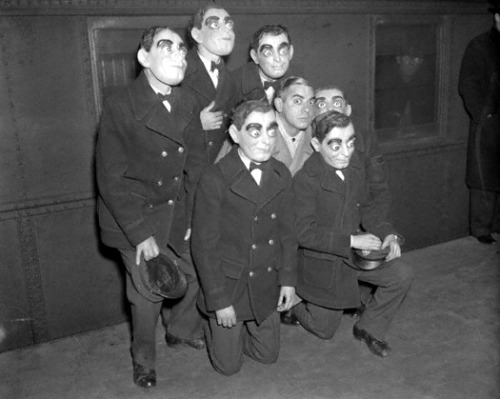Here's another fun piece from my collection of strange (but true) stuff:
Welcome to Weirdsville: This time it's on the largest - non-nuclear - blasts on earth.
KABOOM
For most of us BOOM, KABLAM, KABLOOIE mean a mushroom cloud and a cute little animated turtle talking about ducking and covering – as well as the possible End Of All Life As We Know It.
But, unfortunately, not every monstrous explosion began with J. Robert Oppenheimer saying "Now I am become Death, the destroyer of worlds." Even putting aside natural blasts such as the eruption of Krakatoa, which was so massive the sound of it was heard as far away as London, the earth has still to be rocked by more than its fair share of man-made, non-atomic BOOMs, KABLAMs, and KABLOOIEs.
One of the more terrifying non-nuclear explosions ever to occur was in 1917 up in Halifax, Nova Scotia. Back in December of that year the Mont-Blanc plowed into another ship, the Imo, starting a ferocious fire. Ten minutes later the Mont-Blanc went up, creating what is commonly considered to be one of the largest non-nuclear explosions in earth history.
The Mont-Blanc was a big ship carrying a lot of extremely dangerous cargo – almost 3,000 tons of munitions bound for the war that was then tearing Europe apart. What happened that morning, which lead to the blast and the nightmarish loss of life, reads like a textbook example of whatever could go wrong, did. To avoid being torpedoed, the Mont-Blanc wasn't flying any dangerous cargo flags, so no one except for her crew knew her cargo was so dangerous. When the fire got out of control, the Mont-Blanc's crew tried to warn as many people as possible – but they only spoke French and the language of Halifax was English. Not realizing the danger, crowds began to form to watch the blaze. The Mont-Blanc, on fire, also began to drift toward a nearby pier ... that was also packed with munitions bound for the war.
When everything finally came together – the criminal negligence, the miscommunication, and worst of all the fire and the explosives – the blast was roughly equal to 3 kilotons of TNT. The fireball roared up above the town and the shockwave utterly destroyed the town and everything within one mile of the epicenter. Metal and wreckage fell as far away as 80 miles from the blast and the sound of the detonation was heard more than 225 miles away. The explosion was so huge it generated a tsunami that roared away from the epicenter and then back into the harbor again, adding to the death and destruction.
It wasn't until days later that the true horror of what had happened was realized: Halifax was completely gone, erased from the face of the earth, along with every ship in the harbor and most of the nearby town of Dartmouth. Approximately 2,000 people died from the explosion and another 9,000 were injured.
Unfortunately Halifax wasn't the first such explosives-related accident in 1917. Unbelievably, before the Mont-Blanc destroyed the town, 73 people were killed in the explosion of a munitions factory in Silvertown in West Ham, Essex. The sound was heard as far away as 100 miles. A year earlier, the Johnson Barge No.17 went up Jersey City. Although only a few people were killed, the explosion managed to damage not only Ellis Island but also the Statue of Liberty. There were many other blasts as well, but these are only a few of the more dreadful highlights.
You'd think after these nightmarish explosions, caution about things that go BOOM would have sunk in a bit, but the second world war also saw more than its fair share of explosive accidents. In 1944, for instance, the SS Fort Stikine went up while docked in Bombay, India. When her cargo went up, the blast killed 800 men and injured 3,000. The fire that followed took more than three days to control.
Also in 1944, the UK experienced what is commonly considered the largest blast ever to occur on British soil when 3,700 tons of high explosives were accidentally detonated in an underground munitions store in Fauld, Staffordshire. The explosion was so massive it formed a crater 3⁄4 of a mile across and more than 400 feet deep – and destroyed not only the base but a nearby reservoir (and all the water in it).
But one of the biggest blasts – aside from the two atomic bombs dropped on Japan – was also one of the largest in human history, and one of the most tragic.
Once again in 1944, on July 17 to be specific, munitions being loaded onto a ship in Port Chicago, California, (very close to San Francisco) detonated. No one knows what exactly caused the blast, but the damage was biblical. All in all, more than 5,000 tons of high explosives, plus whatever else was in the stores on the base and on any ships docked, was involved. The explosion was so massive it was felt as far away as Las Vegas (500 miles distant) and people were injured all over the Bay Area when windows were shattered by the immense pressure wave.
320 were killed immediately and almost 400 were seriously injured, but that's not the real tragedy. Most of these men were African American and this single disaster accounted for almost 15% of African American casualties during that war.
Still fearing for their safety, the remaining men, who had just spent three weeks pulling the bodies of their fellow sailors from the wreckage, refused to load any further munitions. The Army, in a characteristic show of support, considered this an act of mutiny and court-martialed 208 sailors, sending an additional 50 to jail for 8 to 15 years.
Fortunately, the 'mutineers' were given clemency after Thurgood Marshall fought for them, though the final member only received justice in 1999 in the form of a Presidential pardon by President Bill Clinton.
Today in Port Chicago there's a marker on the spot and it states that the event was a step toward "racial justice and equality."
And all it took was one of the largest non-nuclear, man-made, blasts in the history of the world – and the deaths of 320 sailors.











































